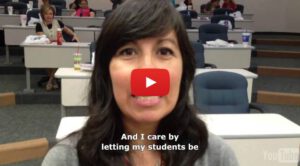
Who Cares About Kelsey? extended trailer
Kelsey Carroll lived with homelessness, self-mutilation, abuse and ADHD. She was a poster child for high school dropouts — until she encountered an education revolution that’s about empowering, not overpowering, our emotionally disabled teens.
Marcel
Marcel, 8, struggles with mental health challenges that have led to fits of violence. His Missouri school attempts to include Marcel in general education classrooms as the school district works to address racial disparities in discipline and education. Marcel highlights the importance of family engagement and cultural responsiveness.
Thasya
Thasya Lumingkewas, 8, has autism and thrives at Maple Wood Elementary with the support of her augmentative communication device.
Education Revolution at Somersworth HS
A closer look at the transformation of Somersworth High School, site of Who Cares About Kelsey?, through School-wide Positive Behavioral Interventions and Supports.
Tariq Zubhuza
Tariq Zubhuza, an inmate at the NH State Prison for Men, discusses the life events and circumstances that led him into the juvenile justice system, and what type of interventions might have put him on a different path. “If you’re 11 years old and you’re drunk, it’s a problem,” Tariq says.
Latoya Fletcher
Latoya Fletcher, an inmate at the NH State Prison for Women, discusses the life events and circumstances that led her into the juvenile justice system, and what type of interventions might have put her on a different path. “My mom was left out of the loop,” Latoya says.
Daniel Frost
Daniel Frost, who is incarcerated at the Sununu Youth Services Center, talks about how he became involved in the juvenile justice system, and what type of interventions might have put him on a different path. “They picked on me a lot. I have Tourette’s,” Daniel says.

Joe Masiello
Joe Masiello, who is incarcerated at the Sununu Youth Services Center, talks about how he became involved in the juvenile justice system, and what type of interventions might have put him on a different path.
Nicole Kasinskas
Nicole Kasinskas, an inmate at the NH State Prison for Women, discusses the life events and circumstances that led her into the juvenile justice system, and what type of interventions might have put her on a different path. “I had no hopes and dreams,” Nicole says.
Axel
Axel is a fifth grader with autism who is non-verbal and exhibits significant behavioral challenges. Through effective communication supports, Axel was able to learn fifth grade general education curriculum in a general education classroom. Support for this film was provided by the National Center and State Collaborative.
Restraint and Seclusion: Hear Our Stories
Six individuals describe their experiences with restraint and seclusion in schools, and the devastating physical and emotional injuries they suffered as a result. Visit StopHurtingKids.com to learn more about the campaign and to download the free discussion guide.
I Care By Campaign
The I Care By campaign gives people specific, personal actions to support students with emotional/behavioral challenges, along with easy ways to share their actions on social media and encourage others to do the same. Watch this video, and if you feel inspired, submit your own video to show that YOU care at ICareBy.org.
Dan and Kelsey at NYU – March 28, 2013
Dan and Kelsey present at an event for the Tisch School of the Arts at NYU, March 28, 2013.
Tariq Zubhuza from Dan Habib on Vimeo.
Julio Panameno from Dan Habib on Vimeo.
MARCEL: OPEN CAPTION from Dan Habib on Vimeo.
THASYA hi-res OPEN CAPTION from Dan Habib on Vimeo.











